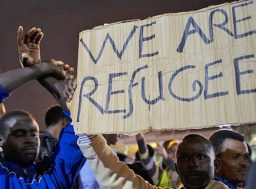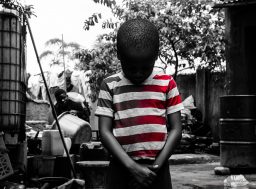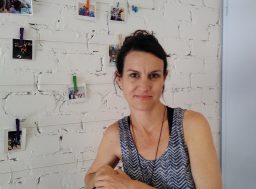
Recently, there have been no reports about torture victims from Sinai. In 2012, when reports about human trafficking were on television and in the print media, the outcry was very loud. However, as loud as it was it quickly faded. The matter vanished into thin air, as if it had never been there.
Do the so-called torture camps, which have become known in 2008, still exist? Are migrants from Eritrea, Sudan and Ethiopia still tortured in brutal ways in order to demand ransom from their relatives – on Sinai or maybe elsewhere? And how are the survivors doing? The people who had to endure unimaginable torture and were released afterwards?
Those who are looking for answers hardly find any. It is difficult to obtain information about the current situation of survivors. There is nothing to be found on the Internet and reports and articles are from 2014 or even earlier. In previous years, only few people knew what was going on in Sinai and today the issue has disappeared completely, although figures show violence on an unimaginable scale. Between 2009 and 2013, an estimated number of about 30,000 people were tortured on Sinai. Over the course of weeks or months, these people have been raped, hit and burnt etc. (source: Van Reisen et.al. 2014: The Human Trafficking Cycle. Sinai and Beyond. Wolf legal publishers). Most of them are from Eritrea and some of them from North Africa. About 10,000 men, women and children have supposedly died in these torture camps.
I have been asking myself these questions, ever since I saw the documentary film “The Sound of Torture”, which shows the cruel fate of torture victims on the Sinai Peninsula. The urgent necessity to find answers to his question leads me to Israel’s capital Tel Aviv. About 7,000 Sinai-survivors have been reported to live in Israel. Maybe I will find answers there.
Levinsky Park
Tel Aviv at the height of summer: a young and busy metropolis with a cosy atmosphere; tanned people enjoying the sun on the beach of Jaffa, modern artists and intellectuals are drinking iced-latte in the cafes around Allenby. It seems I will not find my answers here. Now that I am reaching the south of the city, I feel like I am in the right place. The area around Levinsky Park is bleak and dead. This place is the meeting point for African refugees, who mostly live in the south of Tel Aviv.
And now I finally get to meet some Sinai-survivors. An organisation that works with refugees there introduces me to some of the torture victims. Some of the injuries of these people are immediately visible: scars on their arms and mutilated hands. They have glazed eyes, twitching as if the terror has not come to an end yet. A boy, only eighteen years old, tells me that he is haunted by nightmares every night. He was captured and tortured on Sinai for several weeks and this was two years ago. The fear is still there and he is not only afraid of his memories but he is also scared of the future. The Israeli government refuses visa to him and to most African migrants. He has to live illegally in the country and is not allowed to work or rent a flat. He lives with a distant relative, who pays for his living. He wants to be independent, but he is not yet able to make his own living because he still suffers from the effects of torture. In regular intervals of four weeks, he has to fill in forms to suspend his deportation and every time he has to be afraid to be sent to the detention camp Holot. I have rarely seen a boy who appears to be so alone and without any perspective in such a hostile country.
The lack of perspective is written all over the faces of the Sinai-survivors. They live without documents, rights and without government support in Israel. Some of them tell me about the racisms they are confronted with every day. They tell me about their desire to study but this desire cannot be fulfilled, because they do not have the money for it. The hopes for a better future are limited. And all of this after they already went to hell and back.
The torture victims feel left alone from the global community. However, some of them were lucky. Close to Levinsky Park, I get to meet a young man who works in a cybercafé. He was kidnapped with his wife on Sinai. He now has two daughters and he accepted his situation and tries to make the most of it. In his case, “the most” means living with several bullet wounds on his stomach, which remind him of fleeing from Sinai because he was shot by Egyptian officers on the Israeli border.
Solidarity at the end of all perspectives
It is the solidarity within the Eritrean community that provides stability for torture victims, even in the darkest moments. Those who stranded as migrants in Tel Aviv before a wall had been built on the Israeli border to keep out African refugees who were dropped off in front of Levinsky Park in the south of Tel Aviv. My dialogue partners say that these people were hosted by other refugees who share the same fate. They gave them money and food, unconditional and as long as they were able to make their own living. I am very touched by this strong solidarity. This is a strong contrast to the “looking away” and silence of the so-called global community.
I find some refugee organisations, which support Sinai-Survivors in Tel Aviv. They cover different fields, for instance Hotline for Regugees and Migrants provides legal protections, Physicians for Human Rights-Israel mainly medical care, ASSAF – a partner organisation of Desert Rose – mainly psychosocial support. By publishing reports, the NGOs tried to draw attention to this issue in the previous years. Information about human trafficking was passed on to organisations and addressed to public figures. Despite all that, it remains a mystery why this case did not receive enough international attention. Today, the organisations mainly fight to improve the rights of torture victims in Israel.
The shifting of this phenomenon
And what is currently happening with human trafficking on Sinai? Most people I ask – Eritreans and employees of refugee organisations – think that the business with torturing is not existent in such extreme dimensions anymore. Since the wall on the Israeli border to Sinai has been built, it is difficult to obtain information, because hardly any refugees reach Israel. The people I talked to did not know about a recent case of torturing. According to one of the few current reports about human trafficking on Sinai, the torture camps were closed in the course of anti-terror measures of the Egyptian military. (source: van Reisen, Rijken 2015: Sinai Trafficking: Origin and Definition of a New Form of Human Trafficking. In: Social Inclusion, Volume 3).
Instead, everyone says that this “business model” was shifted to Libya. Refugees are said to be captured there on their way to Europe and are only released for payment of ransom. A young man says that he paid several thousand dollars for his brother who was kidnapped by human traffickers. It is not clear, whether this type of human trafficking is the same as on Sinai, whether telephone torture is used to increase the pressure on relatives or whether the same group of Bedouins are “at work” or not. These questions should be urgently and systematically investigated and in order to avoid that the torture on Sinai is continued elsewhere, it is also important to raise global awareness of this matter.
What remains
After four weeks in Tel Aviv, I leave Israel with a feeling of deep bewilderment. Even after so many encounters with survivors, it seems unreal that I came that close to the horrors of Sinai and spoke to people who actually experienced all this. How is it possible that 30,000 people became victims of torture, mistreatment and murder over the course of six years, without anyone to stop it? How is it possible that these perpetrators are not held accountable to this day? Why are so many torture victims living in poverty and without any perspective and left alone from the rest of the world today? All my experiences in Tel Aviv leave me with deep consternation. It is hard to believe how far the evil powers in humans can go and how easy it is, just to look away. The case of human trafficking on Sinai is one of greatest tragedies of our time. The way survivors are treated also remains an evidence of incapacity of our world’s sympathy.
Author: Lucia Heisterkamp
Translation: Nicole Freibott/ Diana Köth/ Melanie Martin







Follow us